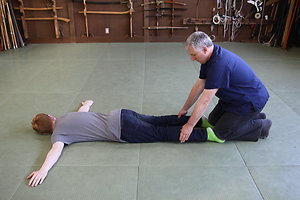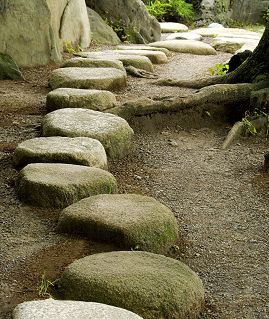Hichibuku Goshin-jutsu Level I
Amatsu Tatara Hichibuku Goshin-jutsu
(天津 蹈鞴 秘致武九護身術)
Gairon (概論) Introduction
Level I - Shokyū (初級) principle: to balance the whole body
Shokyū waza (初級技) 1, 2 & 3
Level 1 general treatment routines (Kata 型) to balance and maintain the patient's body
Japanese integrated movement exercises for practitioners and self-correction exercises, that enable patients to maintain health and to rehabilitate after injury and illness.
Japanese massage, acupressure and reflex points. This promotes repair and the restoration of normal function by releasing muscle tensions, restoring vital energy and improving drainage. This restoration of balance creates a state of health and vitality. Including use of the:
- Thumbs (Shitō Ken 指刀拳 / Boshi ken 拇指拳)
- Palm (Happa ken 八葉拳)
- Side of hand (Kiten Ken 起転拳 / Shuto 手刀)
- Fist (Fudō Ken 不動拳)
- Fingers (Shintan-ken 指単拳)
- Elbows & Forearms (Shuki ken 手起拳 )
- Knees (Sokki-ken 足起拳)
- Feet (Sokuyaku ken 足躍拳 & Sokugyaku ken 足逆拳)
to the: - Upper extremity (Jōshi 上肢)
- Lower extremity (Kashi 下肢)
- Back of the body (Haiseki 背脊)
- Head (Atama 頭)
- Neck (Kubi 首)
Kappō (活法)
Revival methods, including Tsubo (壺) for Kappō (& Kyūsho 急所 vital points for Sappō 殺法) incl. principles of first aid.
Contraindications to Anma technique
Patient / client Assessment - Observation
- Palpation
- Active movements
Health (Kenkō 健康) - Walking (Toho 徒歩)
- Nutrition ( Bujin-shoku 武人 食)
Theory
Introduction & History
Principles of oriental medicine - Yin & Yang / In yō (陰 陽)
- Heaven, Earth & Man / Tenchijin (天地人)
- 5 Elements / Gogyō (五行)
- Sources of Ki (気)
- 12 Meridians / Keiraku ( 十二 経絡)
Anatomy & Physiology - Musculo-skeletal
- Introduction to the body systems
Introduction to clinical practice - Ethics
- Safety
- Hygiene
- Case history taking
(Please note that course contents may be subject to minor variations)

